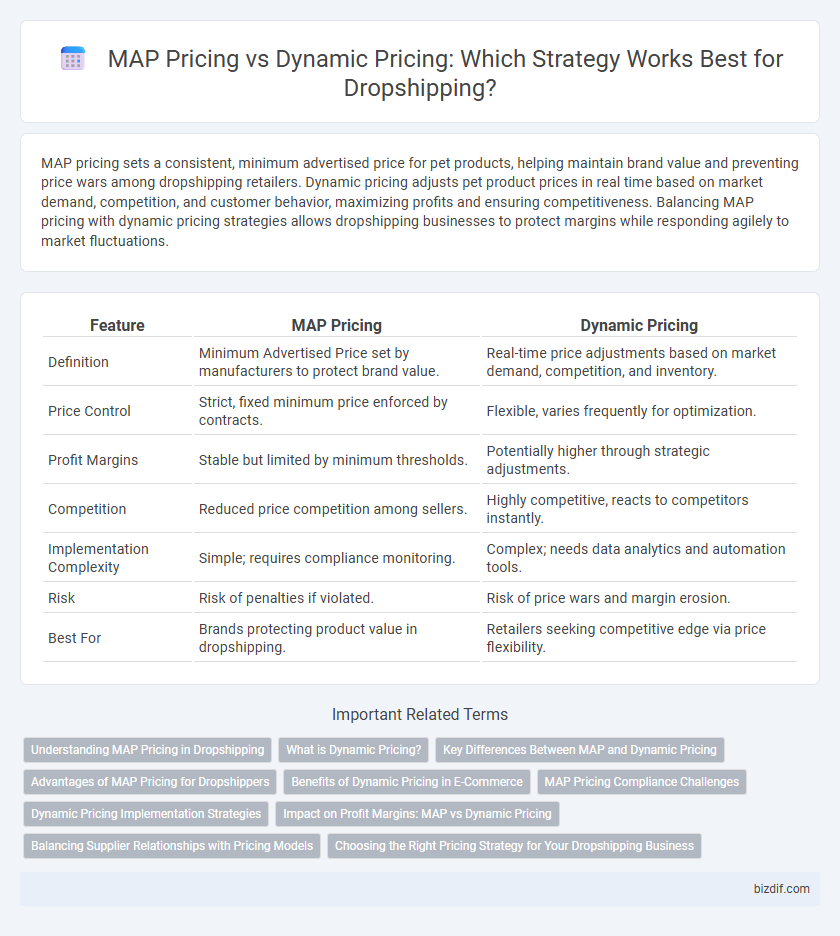MAP pricing sets a consistent, minimum advertised price for pet products, helping maintain brand value and preventing price wars among dropshipping retailers. Dynamic pricing adjusts pet product prices in real time based on market demand, competition, and customer behavior, maximizing profits and ensuring competitiveness. Balancing MAP pricing with dynamic pricing strategies allows dropshipping businesses to protect margins while responding agilely to market fluctuations.
Table of Comparison
| Feature | MAP Pricing | Dynamic Pricing |
|---|---|---|
| Definition | Minimum Advertised Price set by manufacturers to protect brand value. | Real-time price adjustments based on market demand, competition, and inventory. |
| Price Control | Strict, fixed minimum price enforced by contracts. | Flexible, varies frequently for optimization. |
| Profit Margins | Stable but limited by minimum thresholds. | Potentially higher through strategic adjustments. |
| Competition | Reduced price competition among sellers. | Highly competitive, reacts to competitors instantly. |
| Implementation Complexity | Simple; requires compliance monitoring. | Complex; needs data analytics and automation tools. |
| Risk | Risk of penalties if violated. | Risk of price wars and margin erosion. |
| Best For | Brands protecting product value in dropshipping. | Retailers seeking competitive edge via price flexibility. |
Understanding MAP Pricing in Dropshipping
Minimum Advertised Price (MAP) pricing in dropshipping sets a baseline price below which retailers cannot publicly advertise products, ensuring brand value and market stability. Adhering to MAP pricing protects suppliers from price erosion caused by aggressive discounting and prevents undercutting among sellers. Understanding the MAP policy is crucial for dropshippers to maintain compliance with supplier agreements and avoid penalties or account termination.
What is Dynamic Pricing?
Dynamic pricing is a strategy where product prices fluctuate based on real-time market demand, competitor pricing, and inventory levels to maximize sales and profit margins. Unlike Minimum Advertised Price (MAP) policies that set a fixed lowest price, dynamic pricing leverages algorithms and data analytics to continuously adjust prices for optimal competitiveness. This approach benefits dropshipping businesses by enabling flexible pricing that responds instantly to market changes and consumer behavior.
Key Differences Between MAP and Dynamic Pricing
MAP pricing enforces a minimum advertised price set by manufacturers to protect brand value and retailer margins, ensuring price consistency across sellers. Dynamic pricing adjusts prices in real-time based on market demand, competitor actions, and inventory levels to maximize sales and profit margins. The key difference lies in MAP's fixed pricing constraints versus dynamic pricing's flexible, data-driven approach for competitive pricing strategies.
Advantages of MAP Pricing for Dropshippers
MAP (Minimum Advertised Price) pricing ensures consistent product value across multiple sellers, protecting brand reputation and preventing price wars among dropshippers. It fosters reliable profit margins by setting a baseline price, reducing the risk of price undercutting that can erode earnings. This pricing strategy builds trust with suppliers and customers, ensuring stable market conditions ideal for sustainable dropshipping growth.
Benefits of Dynamic Pricing in E-Commerce
Dynamic pricing in e-commerce enables dropshipping businesses to maximize revenue by automatically adjusting product prices in real-time based on market demand, inventory levels, and competitor pricing. This approach enhances competitiveness by responding swiftly to market fluctuations, optimizing profit margins while maintaining customer attraction. Unlike MAP pricing, which enforces fixed minimum prices, dynamic pricing provides flexibility to capitalize on peak shopping periods and clearance sales efficiently.
MAP Pricing Compliance Challenges
MAP pricing compliance challenges in dropshipping arise from the difficulty in monitoring numerous resellers who may undercut minimum advertised prices to gain market share. Enforcing MAP agreements requires robust tracking tools and consistent communication to ensure all sellers adhere to policies and avoid price wars that can erode brand value. Non-compliance risks include reduced manufacturer trust, potential penalties, and damage to retailer relationships, making effective compliance management essential for sustainable dropshipping success.
Dynamic Pricing Implementation Strategies
Dynamic pricing implementation in dropshipping leverages real-time market data, competitor pricing, and demand fluctuations to optimize product prices continuously. Employing AI-driven algorithms enables automated price adjustments that maximize profit margins while maintaining competitive positioning. Integrating dynamic pricing tools with e-commerce platforms ensures seamless updates, improving responsiveness and customer satisfaction.
Impact on Profit Margins: MAP vs Dynamic Pricing
MAP pricing enforces a minimum advertised price set by manufacturers, safeguarding profit margins by preventing undercutting among retailers. Conversely, dynamic pricing adjusts prices in real-time based on demand, competition, and inventory levels, potentially increasing sales velocity but risking thinner profit margins due to frequent price changes. For dropshipping businesses, striking a balance between MAP compliance and dynamic pricing strategies is crucial to maintaining stable profits while staying competitive in fluctuating markets.
Balancing Supplier Relationships with Pricing Models
MAP pricing ensures consistent brand value and protects supplier agreements by setting minimum prices retailers must adhere to, preventing price erosion and fostering long-term partnerships. Dynamic pricing enhances competitiveness by allowing real-time price adjustments based on market demand, inventory, and competitor actions, but may risk violating MAP policies and straining supplier trust. Striking a balance involves integrating MAP guidelines within dynamic pricing strategies to maintain supplier relationships while optimizing revenue and market responsiveness.
Choosing the Right Pricing Strategy for Your Dropshipping Business
Selecting the optimal pricing strategy for your dropshipping business hinges on understanding the benefits of MAP pricing versus dynamic pricing. MAP (Minimum Advertised Price) pricing helps maintain brand value and prevents price wars by setting a floor price that resellers cannot advertise below, ensuring consistent profit margins. Dynamic pricing leverages real-time market data and competitor prices to maximize sales and profit by adjusting prices based on demand, inventory levels, and customer behavior.
MAP Pricing vs Dynamic Pricing Infographic

 bizdif.com
bizdif.com